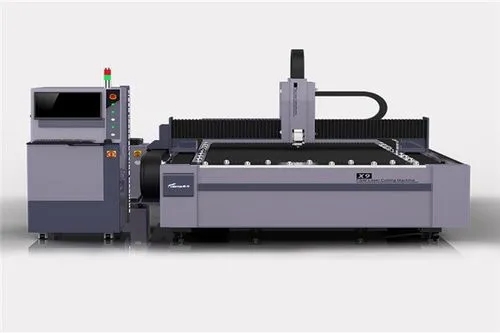
(1) Good cutting quality
① The laser cutting incision is thin and narrow, and the two sides of the cutting seam are parallel and perpendicular to the surface;
② The cutting surface is smooth and beautiful, and the surface roughness is only tens of microns. Even laser cutting can be used as the last process without processing, and the parts can be used directly;
③ After laser cutting the material, the width of the heat-affected zone is very small, and the properties of the material near the cutting seam are hardly affected.
In addition, the deformation of the workpiece is small, the cutting precision is high, the geometric shape of the cutting seam is good, and the cross-sectional shape of the cutting seam is a regular rectangle.
(2) High cutting efficiency. Due to the transmission characteristics of the laser, the laser cutting machine is generally equipped with
Equipped with multiple CNC workbenches, the entire cutting process can be CNC controlled. In the process of operation, only by changing the NC program can it be applied to the cutting of parts of different shapes, not only two-dimensional cutting, but also three-dimensional cutting can be realized.
(3) The cutting speed is fast.
(4) Non-contact cutting During the laser cutting process, the cutting torch has no contact with the workpiece, and there is no tool wear. To process parts of different shapes, there is no need to change the “tool”, just change the output parameters of the laser. The laser cutting process has the advantages of low noise, small vibration, and no pollution.
(5) There are many kinds of cutting materials. Compared with oxyacetylene cutting and plasma cutting, laser cutting can be used in a wide variety of materials, including metals, non-metals, metal-based and non-metal-based composites, leather, wood and fibers. However, different materials show different suitability for laser cutting due to their different thermophysical properties and laser absorption. Using CO2 lasers, the laser cutting performance of various materials is shown in Table 2. Most laser cutting machines are controlled by numerical control programs or made of cutting robots. As a precision processing method, laser cutting can cut almost all materials, including two-dimensional cutting or three-dimensional cutting of sheet metal. In the field of automobile manufacturing, the cutting technology of space curves such as roof windows has been widely used. Volkswagen uses the most powerful lasers to cut complex body panels and various curved parts. In the aerospace field, laser cutting and processing aerospace parts include engine flame tubes, titanium alloy thin-walled gearboxes, aircraft frames, titanium alloy skins, wing trusses, tail panels, helicopter main rotors, and space shuttle ceramic insulation tiles. And other laser cutting forming technologies are also widely used in the field of non-metallic materials. Such as silicon nitride, ceramics, quartz, etc.; flexible materials, such as cloth, paper, plastic board, rubber, etc.




